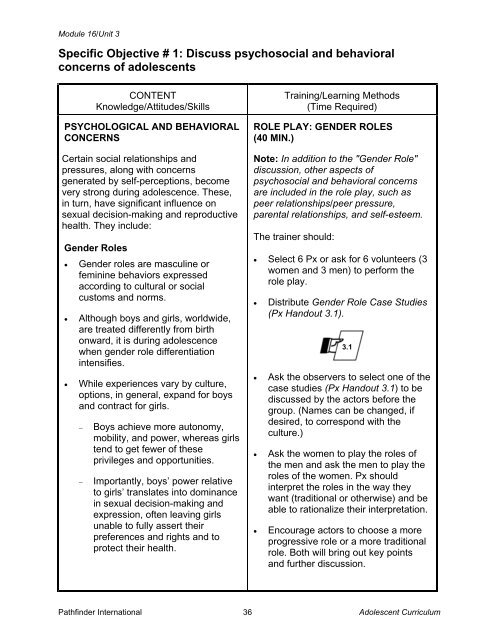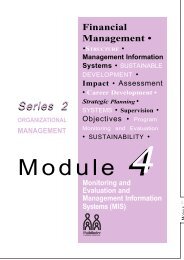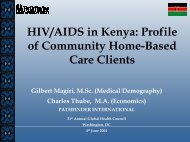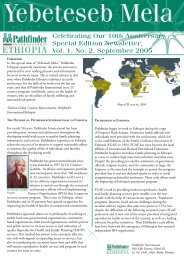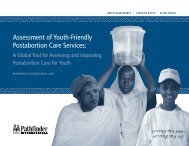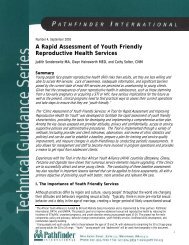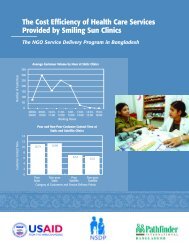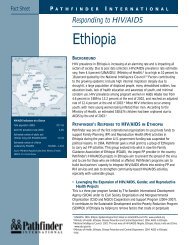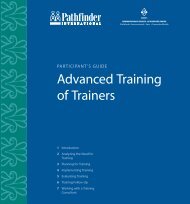reproductive health services for adolescents - Pathfinder International
reproductive health services for adolescents - Pathfinder International
reproductive health services for adolescents - Pathfinder International
Create successful ePaper yourself
Turn your PDF publications into a flip-book with our unique Google optimized e-Paper software.
Module 16/Unit 3<br />
Specific Objective # 1: Discuss psychosocial and behavioral<br />
concerns of <strong>adolescents</strong><br />
CONTENT<br />
Knowledge/Attitudes/Skills<br />
PSYCHOLOGICAL AND BEHAVIORAL<br />
CONCERNS<br />
Certain social relationships and<br />
pressures, along with concerns<br />
generated by self-perceptions, become<br />
very strong during adolescence. These,<br />
in turn, have significant influence on<br />
sexual decision-making and <strong>reproductive</strong><br />
<strong>health</strong>. They include:<br />
Gender Roles<br />
• Gender roles are masculine or<br />
feminine behaviors expressed<br />
according to cultural or social<br />
customs and norms.<br />
• Although boys and girls, worldwide,<br />
are treated differently from birth<br />
onward, it is during adolescence<br />
when gender role differentiation<br />
intensifies.<br />
• While experiences vary by culture,<br />
options, in general, expand <strong>for</strong> boys<br />
and contract <strong>for</strong> girls.<br />
−<br />
−<br />
Boys achieve more autonomy,<br />
mobility, and power, whereas girls<br />
tend to get fewer of these<br />
privileges and opportunities.<br />
Importantly, boys’ power relative<br />
to girls’ translates into dominance<br />
in sexual decision-making and<br />
expression, often leaving girls<br />
unable to fully assert their<br />
preferences and rights and to<br />
protect their <strong>health</strong>.<br />
Training/Learning Methods<br />
(Time Required)<br />
ROLE PLAY: GENDER ROLES<br />
(40 MIN.)<br />
Note: In addition to the "Gender Role"<br />
discussion, other aspects of<br />
psychosocial and behavioral concerns<br />
are included in the role play, such as<br />
peer relationships/peer pressure,<br />
parental relationships, and self-esteem.<br />
The trainer should:<br />
• Select 6 Px or ask <strong>for</strong> 6 volunteers (3<br />
women and 3 men) to per<strong>for</strong>m the<br />
role play.<br />
• Distribute Gender Role Case Studies<br />
(Px Handout 3.1).<br />
3.1<br />
• Ask the observers to select one of the<br />
case studies (Px Handout 3.1) to be<br />
discussed by the actors be<strong>for</strong>e the<br />
group. (Names can be changed, if<br />
desired, to correspond with the<br />
culture.)<br />
• Ask the women to play the roles of<br />
the men and ask the men to play the<br />
roles of the women. Px should<br />
interpret the roles in the way they<br />
want (traditional or otherwise) and be<br />
able to rationalize their interpretation.<br />
• Encourage actors to choose a more<br />
progressive role or a more traditional<br />
role. Both will bring out key points<br />
and further discussion.<br />
<strong>Pathfinder</strong> <strong>International</strong><br />
36<br />
Adolescent Curriculum


